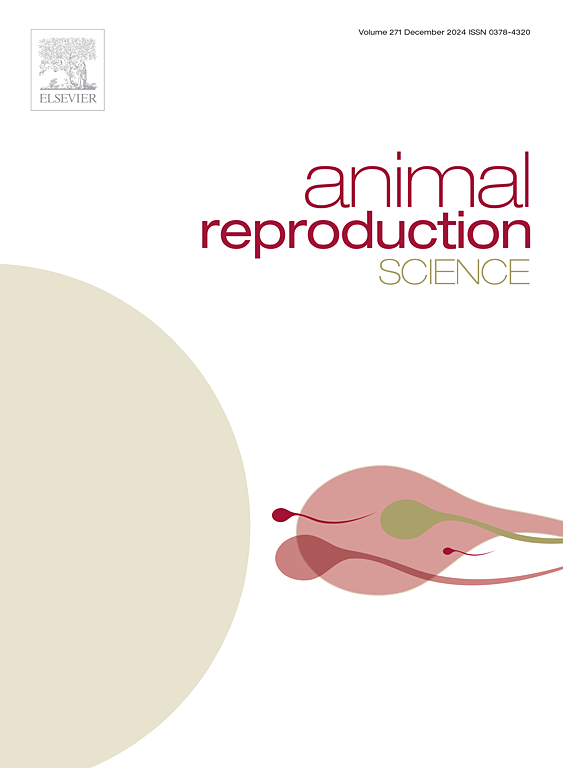Vitamin E nanoemulsion enhances porcine sperm quality and reproductive performance via antioxidant enhancement and fatty acid metabolism regulation
IF 3.3
2区 农林科学
Q1 AGRICULTURE, DAIRY & ANIMAL SCIENCE
引用次数: 0
Abstract
Vitamin E (VE) is widely used as an antioxidant in boar semen preservation. Its low water solubility and limited bioavailability, however, compromise its functional efficacy during storage. To address these limitations, we developed a lecithin-stabilized vitamin E nanoemulsion (NE) to enhance its dispersibility and antioxidant efficacy. Semen from Duroc boars was diluted in Beltsville thawing solution (BTS) containing either 0.6 mM NE, 4 mM free VE, or no additive, and stored at 17 °C. Compared to VE and control groups, NE significantly enhanced sperm motility, preserved the structural integrity of the plasma and acrosomal membranes, and maintained mitochondrial function, while reducing oxidative stress and DNA fragmentation over a 7d storage period (P < 0.01). Untargeted metabolomics revealed that NE supplementation regulated key pathways including unsaturated fatty acid metabolism and glutathione-related antioxidation. Artificial insemination (AI) trials involving 637 sows confirmed that NE-treated semen improved total and healthy piglet numbers per litter (P < 0.05), without adverse effects. These findings suggest that NE provides an effective and practical strategy for enhancing boar semen preservation and reproductive outcomes in porcine production.
维生素E纳米乳通过增强抗氧化和调节脂肪酸代谢来提高猪精子质量和繁殖性能
维生素E (VE)作为抗氧化剂被广泛应用于猪精液保存中。然而,其低水溶性和有限的生物利用度影响了其在储存期间的功能功效。为了解决这些限制,我们开发了一种卵磷脂稳定的维生素E纳米乳(NE),以提高其分散性和抗氧化功效。杜洛克公猪精液用含0.6 mM NE、4 mM游离VE或不含添加剂的Beltsville解冻液(BTS)稀释,保存在17 °C。与VE和对照组相比,NE显著提高了精子活力,保持了血浆和顶体膜的结构完整性,维持了线粒体功能,同时在7d的储存期内减少了氧化应激和DNA断裂(P <; 0.01)。非靶向代谢组学显示,NE补充剂调节了不饱和脂肪酸代谢和谷胱甘肽相关抗氧化等关键途径。涉及637头母猪的人工授精(AI)试验证实,经ne处理的精液提高了每窝仔猪的总产仔数和健康仔猪数(P <; 0.05),无不良反应。这些结果表明,在猪生产中,NE为提高猪精液保存和繁殖结果提供了有效和实用的策略。
本文章由计算机程序翻译,如有差异,请以英文原文为准。
求助全文
约1分钟内获得全文
求助全文
来源期刊

Animal Reproduction Science
农林科学-奶制品与动物科学
CiteScore
4.50
自引率
9.10%
发文量
136
审稿时长
54 days
期刊介绍:
Animal Reproduction Science publishes results from studies relating to reproduction and fertility in animals. This includes both fundamental research and applied studies, including management practices that increase our understanding of the biology and manipulation of reproduction. Manuscripts should go into depth in the mechanisms involved in the research reported, rather than a give a mere description of findings. The focus is on animals that are useful to humans including food- and fibre-producing; companion/recreational; captive; and endangered species including zoo animals, but excluding laboratory animals unless the results of the study provide new information that impacts the basic understanding of the biology or manipulation of reproduction.
The journal''s scope includes the study of reproductive physiology and endocrinology, reproductive cycles, natural and artificial control of reproduction, preservation and use of gametes and embryos, pregnancy and parturition, infertility and sterility, diagnostic and therapeutic techniques.
The Editorial Board of Animal Reproduction Science has decided not to publish papers in which there is an exclusive examination of the in vitro development of oocytes and embryos; however, there will be consideration of papers that include in vitro studies where the source of the oocytes and/or development of the embryos beyond the blastocyst stage is part of the experimental design.
 求助内容:
求助内容: 应助结果提醒方式:
应助结果提醒方式:


